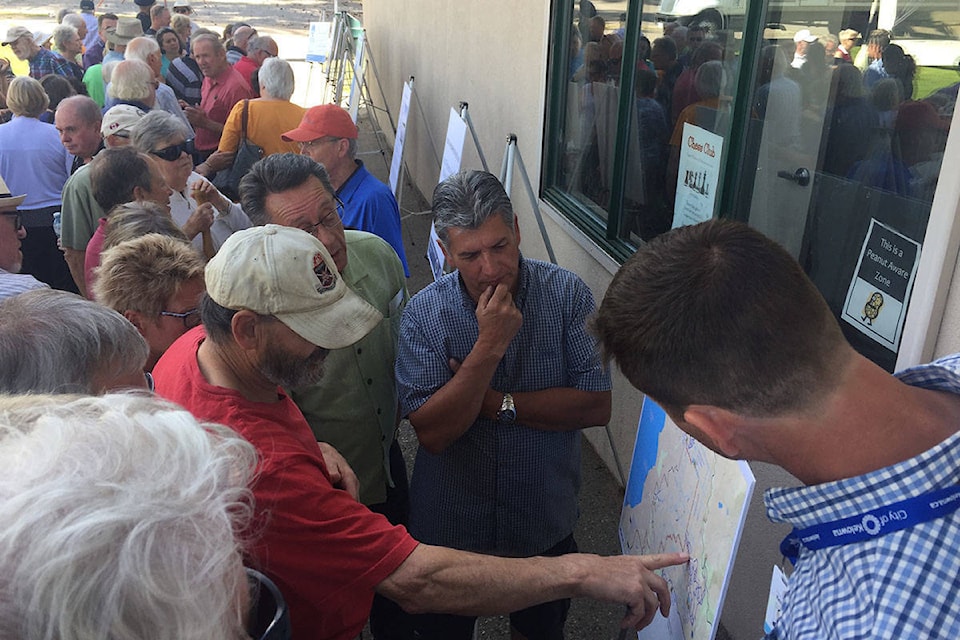Increasing gas-powered motorized boating traffic could inevitably clash with water quality management needs for Okanagan Lake, predicts a Kelowna city councillor.
Coun. Luke Stack says when that happens will raise “delicate” water management decisions will the city and other jurisdictional interests overseeing management of the lake and watershed tributaries feeding into it.
Stack said with Kelowna’s population alone expected to increase by 50,000 over the next decade, more people is going to mean greater recreational use pressure on the lake, in particular more gas-powered motorboats.
“I know this is a delicate subject but I think it will be an important one as we move forward,” Stack said.
The councillor made the comments at the Monday morning council meeting following a presentation from city staff on developing an integrated water management plan now that the city has taken over and is expanding what was the former Southeast Kelowna Irrigation District water supply system.
RELATED: Kal/Wood Lake study stresses need to protect drinking water
Stack noted that strict limitations are placed on boating and recreational property development around area reservoirs, but Okanagan Lake recreational use continues to escalate.
“I understand how important recreational use of the lake plays in our tourism industry, but there has to be a point where that growth of population density is reflected in recreational demands on the lake to where it reaches a point of concern regarding the lake’s water quality,” he said.
Ann Warwick Sears, executive director of the Okanagan Basin Water Board, attended the council meeting and was asked to address the recreational boat issue on Okanagan Lake.
Warwick Sears said boating density is difficult to navigate because there are so many access points from various communities that touch on the lake.
“We have not figured out how to move forward regarding motorboat capacity and the lake falls under provincial jurisdiction so there are a lot of competing interests at play there,” Warwick Sears said.
She said a study done about a decade ago regarding the impact of recreational boat use didn’t go anywhere because it was considered far too controversial at the time.
She noted that a boating impact study was done recently for Kalamalka Lake and Wood Lake, coordinated by the Okanagan Collaborative Conservation Program. The organization is currently in the preliminary stages of coordinating a similar study for Okanagan Lake.
The Kalamalka-Wood Lake study found the lakes had more capacity for boating traffic but raised suggestions about limiting motorized boat traffic in ecologically sensitive foreshore areas and around domestic water in-take points.
Ron Westlake, senior engineer with the City of Kelowna, was joined by utility planning manager Rod MacLean, in presenting the water management outlook to city council.
Westlake said the city is in the midst of connecting Southeast Kelowna domestic water users to the city water system, with the assistance of $43.9 million in provincial/federal grants. Construction of phase one of the integration project is at the mid-way point, with project completion targeted for Jan. 1, 2020.
RELATED: SEKID is dissolved
SEKID was dissolved in May and the organization and water management operations incorporated into city operations. Agricultural water users will continue to be supplied water from the former SEKID managed system.
“That has enabled a 20 to 25 per cent increase in water supply capacity for those agricultural users with the capacity relief provided from access to our city water infrastructure, ” Westlake noted.
Similar efforts on a smaller scale have also received grant funding $12 million, to upgrade the water infrastructure for South Okanagan-Mission agricultural users.
But Westlake noted as the City of Kelowna expands its water management interests, it also becomes a stakeholders in water issues occurring outside its civic boundary jurisdictions, from managing reservoirs and dams to participating in the decision-making process on decisions affecting watershed headwaters.
And it also steps into the oversight role of managing water supply and dictating user rates for agricultural users, something Coun. Mohini Singh noted is not lost on local farmers who rely on low-cost water in particular for fruit crops.
Westlake said SEKID rates will remain in place until 2021, and any change will not come without extensive consultation with the agricultural community.
He stressed the need for the city to continue working to enhance its water supply research data collection such as for streamflow levels and water flow temperatures, along with collaborating with the myriad of jurisdictional interests in the Okanagan Lake watershed, such as the provincial government, Okanagan Basin Water Board and Okanagan Nation Alliance.
Westlake cited four areas of water management as key components of any Kelowna area water management plan—water supply, flood protection, wastewater control and eco-system preservation.
“We should review the current state of management practices with each component and collaborate with others to compare those practices with our collection visions or individual needs,” he said.
He said the city is currently involved in a six-month analysis study, started in November 2018, with various stakeholders on how to move forward in managing the valley’s water asset and work together on securing senior government grants and plan larger joint enhancement initiatives.
barry.gerding@blackpress.ca
Like us on Facebook and follow us on Twitter
